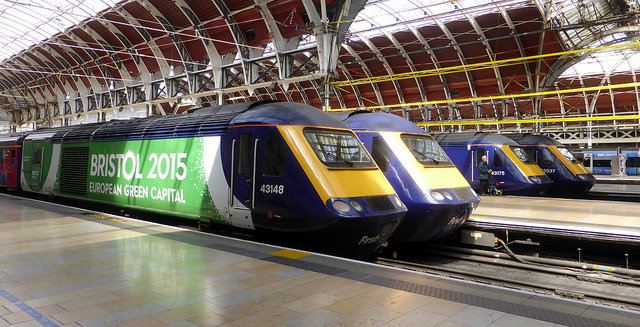Richard Pancost, director of the Cabot Institute discusses how green Bristol is as a city and a university
In 2015, Bristol served as the UK’s first – and potentially its last – European Green Capital. It was an exhilarating and generally optimistic year, in which the University staff and students were enthusiastic and ubiquitous participants. And it culminated in the city and University attending the Paris Climate Summit where an ambitious new agreement to address climate change was finally agreed.
Since then, the University has appointed a new Vice Chancellor, and the city has elected a new Mayor. The country has had a general election and voted for Brexit. The world’s 2nd largest carbon polluter has elected Donald Trump to be its President. That is a lot of change! So what has been achieved and where are we now going?
the legacy still thrives but not without complication
The 2015 year itself was not free of controversy but was generally viewed as a success for our city. It raised the city’s global profile and showcased our many successes in cycling, recycling, community activism, and renewable energy. It engaged hundreds of thousands, including about 30,000 school children, launched the Shawn the Sheep Sustainability game, attracted global investment and fostered new Council policies. The University participated in the year’s delivery, held dozens of events, supported dozens of others and made several pledges to act. Central to this involvement were the students who contributed over 60,000 hours of volunteering to sustainability initiatives.
Great job @cpe_bristol working on #Bristol Futures and developing opportunities for students to work on live projects with partners in the city. https://t.co/SCP9AymU9W
— Cabot Institute (@cabotinstitute) February 22, 2018
The Cabot Institute was involved in the Green Capital almost all the way back to its inception, and in 2014 our first Manager, Philippa Bayley, was elected to be co-chair of the Bristol Green Capital Partnership (BGCP), thought to be the world’s largest local network of environmental organisations. During the year, we were proud to showcase the amazing research in the University, from climate resilience to urban pollinators.
We also supported our student initiatives; partnered with brilliant organisations in the city, like the BGCP but also businesses and the voluntary sector; contributed to much of the Arts Programme, including Luke Jerrams’ brilliant Withdrawn in Leigh Woods (and even commissioned some of our own art - that Alex Lucas Plesiosaur on Park Row!); and produced new research that helped inform Bristol’s new policies.
And now?
Now, I think, the legacy still thrives but not without complication. Mayor Marvin Rees re-committed the city to George Ferguson’s pledge to be carbon neutral by 2050, and the One City Plan currently in development promises to have bold new targets around plastic use, recycling, transport and energy. However, the city is also grappling with the pressures of central government-imposed austerity, which threatens a sharp reduction in park funding and has undermined other programmes.
The Bristol Green Capital Partnership is thriving and on firmer financial ground; and it is now entrenched in city discussions, including pacing the ambitious environmental policies of the One City Plan. However, the voluntary and charity sectors that were so crucial to the success of the Green Capital are under much financial stress.
the drive towards a sustainable future for Bristol is not as challenging as it seems now
The University has certainly doubled down on its commitment to the environment. To build research capacity, we continue to appoint world leaders in topics ranging from climate change and renewable energy to low-carbon computing and sustainable supply chains. We have moved forward on our pledges, including continued investment in low carbon district heating, ongoing reform of our procurement and recently announcing our first success in divestment from fossil fuels. There is a long way to go, however, if we are to achieve our pledge to be carbon neutral by 2030.
The legacy of our student engagement during 2015 is perhaps the most profound. That programme led to the Skills Bridge initiative and was one of the key inspirations for our ambitious Bristol Futures programme, which also centres the mutually beneficial collaboration between our students and our partners. One of the main strands of Bristol Futures is Sustainable Futures, a programme that draws on past student and partner initiatives during the Green Capital Year to inspire new students. And of course, independent of University initiatives, our students and student societies carry on doing amazing volunteer work, innovating, inventing and helping solve problems across the city.

Flickr/Train Photos
Nonetheless, with all that is happening from park budget cuts to daily Trump tweets, it is easy to become discouraged. But the drive towards a sustainable future for Bristol is not as challenging as it seems now and was not as assured as it seemed at the end of 2015. An example of the difficult but encouraging progress has been the Green and Black Ambassadors Programme, a partnership between Cabot, the BGCP and Ujima Radio.
Ujima recognised that despite the Green Capital Year’s success, it failed to bridge the inclusion gaps in the city and truly engage with and celebrate what was happening in black and minority ethnic communities. The Ambassadors have tackled that over the past two years, profiling this activity, inspiring a new generation of environmental leaders and challenging our well-meaning institutions. It is constant reminder of how complicated and multi-faceted the challenge of environmental sustainability will be. But it is also a reminder of how rewarding it is to work together to achieve it.
Featured image: Unsplash/Ashes Sitoula









